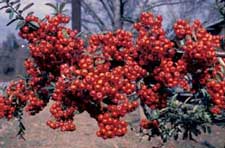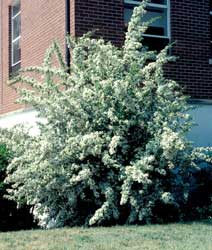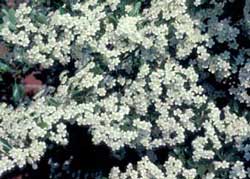Landscape Shrubs
Pyracantha, Firethorn
(Prunus coccinea)
Starting in mid- to late April, the Pyracantha in central Arkansas begin an exceptional white flower display that lasts about 2 weeks. While individual flowers are small, they are born in 2” diameter clusters that typically cover the plant. Flowers are born outside the dark evergreen foliage, so they stand out like white sparklers. Plants tend to flower even when young, and mature plants bloom very heavily as long as they are in a good site. Like several other plants of the rose family (Rosaceae), the flowers do not have a pleasant odor.
In September, those thousands of small white flowers turn into brilliant orange to red pea-sized fruits. The fruit display, like the flower display, is exceptional and typically lasts until early January when they are eaten by birds. For some reason birds take these before they eat deciduous holly (Ilex decidua or verticillata) or hawthorn (Crataegus) fruits.
Pyracantha is a broadleaf evergreen plant with leaves that do not change color in the winter months. The leaves, which are narrow elliptic, are typically a dark green and slightly glossy. The foliage gives the plant a fine texture.
Plant habit is a bit difficult to describe since it can be trained in different ways, and cultivars are available in various sizes. The standard habit is a large shrub (10’ by 10’) with uniform sprays of stiff branches emanating from the center. Most people choose to shear this plant into balls, cones, or hedges. It is very common to see gardeners training this on a wall or lattice as an espalier plant. There are a number of cultivars available that are smaller in size. Cultivars offer a variety of fruit colors and plant sizes.
Cultural requirements for firethorn are fairly specific. You can avoid most problems by situating this plant in full sun. The plant flowers/fruits less as the amount of shade is increased; shade also increases the risk of disease. The soil should be well-drained and acidic.
Firethorn is plagued by several serious insect and disease problems. Common problems include spider mites and the bacterial disease fireblight. Other serious problems include lace bug, scales, aphids on new growth, and a leaf spot disease that disfigures the fruit.
- Common Name: firethorn
- Varieties to look for: many
- Flower Color: white (showy)
- Blooming period: mid- to late April
- Type: broadleaf evergreen shrub
- Size: large shrub; 10’ tall x 10’ wide
- Exposure: full sun
- Soil: well-drained, slightly acid
- Watering: fairly tolerant
- When to prune: after flowering
- Suggested use: trellis, mixed shrub border
Fruit cluster

Form with flowers

Flowers
